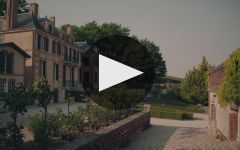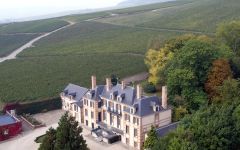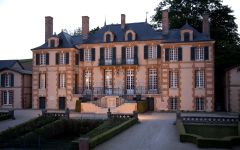Taittinger Brut Millesime 2015
-
James
Suckling -
Jeb
Dunnuck -
Wine
Spectator -
Robert
Parker - Decanter



Product Details
Your Rating
Somm Note
Winemaker Notes
This Champagne is pale gold in the glass with fine, pinpoint bubbles. On the nose, aromas of white fruit and wild berries precede flavors of toast and yeast. Excellent minerality and refined acidity culminate in a lasting, full-bodied, round finish.
Professional Ratings
-
James Suckling
This is a vivid Taittinger with notes of chalk, almond croissants, lemon curd and biscuits. Bright and linear, with a tight bead of bubbles. Focused with persistent pastry notes. 50% pinot noir and 50% chardonnay; 70% Grands Crus and 30% Premiers Crus. Drink or hold.
-
Jeb Dunnuck
The same vintage I tasted last year, the 2015 Champagne Millésime Brut pours a bright straw hue and has developed more attractive aromatics since last year. Raised entirely in stainless steel tank for this vintage, with 9 grams per liter dosage, it’s equal parts Chardonnay and Pinot Noir, with 70% of the best grapes from the Grand Cru villages and 30% of the best wines from the Premier Cru Villages. Lush with aromatics of wet stone, orange marmalade, and ripe apricot, it takes on a darker mineral undertone. Fleshy and full-bodied, it has a bit of bitter citrus on the finish.
-
Wine Spectator
Vibrant and harmonious, with a pleasing range of ripe pear and nectarine, toast point and salted almond, candied lemon peel and spun honey riding the finely detailed bead. Chardonnay and Pinot Noir.
-
Robert Parker's Wine Advocate
Taittinger’s 2015 Brut Millésimé is a blend of 50% Chardonnay and 50% Pinot Noir from various villages, 70% of which are grands crus. It has an elegant, floral bouquet with aromas of honeysuckle, lime tree, citrus oil, orchard fruit and almonds. It’s moderately weighted and perfectly balanced with a delicate mousse and a refined, elegant and mineral finish. This well-crafted, superb cuvée requires patience to fully realize its potential.
-
Decanter
A classic style with honeyed creamy, quince and spices aromas. Lovely palate with hazelnuts and toasty notes. Attractive long finish. Blend : 50% Chardonnay, 50% Pinot Noir
Other Vintages
2014-
Tasting
Panel -
Wine
Enthusiast -
James
Suckling -
Robert
Parker
-
Tasting
Panel -
James
Suckling -
Robert
Parker
-
Wine
Enthusiast -
James
Suckling -
Wine
Spectator -
Robert
Parker - Decanter
-
Wine
Enthusiast -
Wine
Spectator -
Wine &
Spirits
-
Wine
Enthusiast -
Wilfred
Wong -
James
Suckling -
Wine
Spectator -
Robert
Parker
-
Wine
Spectator -
Wine
Enthusiast -
Connoisseurs'
Guide -
Robert
Parker
-
Wine
Enthusiast
-
Wine
Spectator -
Robert
Parker
-
Wine
Enthusiast -
Wine &
Spirits
-
Connoisseurs'
Guide -
Wine
Spectator -
Wine
Enthusiast








Champagne Taittinger was established in 1931 by Pierre Taittinger on the foundations of Forest-Forneaux, itself established in 1734 and the third-oldest wine producing house of Champagne. Taittinger is today proprietor of approximately 600 acres of vines among which are included parcels in the one hundred - percent rated villages of Cramant and Avize in the Cote des Blancs; and Bouzy, Mailly, Ambonnay and Verzenay in the Montagne de Reims. The Taittinger Estate is one of the three most extensive in the Champagne district, and the firm's major holdings in Chardonnay vineyards are the physical expression of the Taittinger philosophy and style.

Representing the topmost expression of a Champagne house, a vintage Champagne is one made from the produce of a single, superior harvest year. Vintage Champagnes account for a mere 5% of total Champagne production and are produced about three times in a decade. Champagne is typically made as a blend of multiple years in order to preserve the house style; these will have non-vintage, or simply, NV on the label. The term, "vintage," as it applies to all wine, simply means a single harvest year.

Associated with luxury, celebration, and romance, the region, Champagne, is home to the world’s most prized sparkling wine. In order to bear the label, ‘Champagne’, a sparkling wine must originate from this northeastern region of France—called Champagne—and adhere to strict quality standards. Made up of the three towns Reims, Épernay, and Aÿ, it was here that the traditional method of sparkling wine production was both invented and perfected, birthing a winemaking technique as well as a flavor profile that is now emulated worldwide.
Well-drained, limestone and chalky soil defines much of the region, which lend a mineral component to its wines. Champagne’s cold, continental climate promotes ample acidity in its grapes but weather differences from year to year can create significant variation between vintages. While vintage Champagnes are produced in exceptional years, non-vintage cuvées are produced annually from a blend of several years in order to produce Champagnes that maintain a consistent house style.
With nearly negligible exceptions, . These can be blended together or bottled as individual varietal Champagnes, depending on the final style of wine desired. Chardonnay, the only white variety, contributes freshness, elegance, lively acidity and notes of citrus, orchard fruit and white flowers. Pinot Noir and its relative Pinot Meunier, provide the backbone to many blends, adding structure, body and supple red fruit flavors. Wines with a large proportion of Pinot Meunier will be ready to drink earlier, while Pinot Noir contributes to longevity. Whether it is white or rosé, most Champagne is made from a blend of red and white grapes—and uniquely, rosé is often produce by blending together red and white wine. A Champagne made exclusively from Chardonnay will be labeled as ‘blanc de blancs,’ while ones comprised of only red grapes are called ‘blanc de noirs.’
